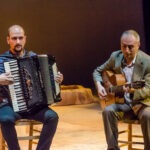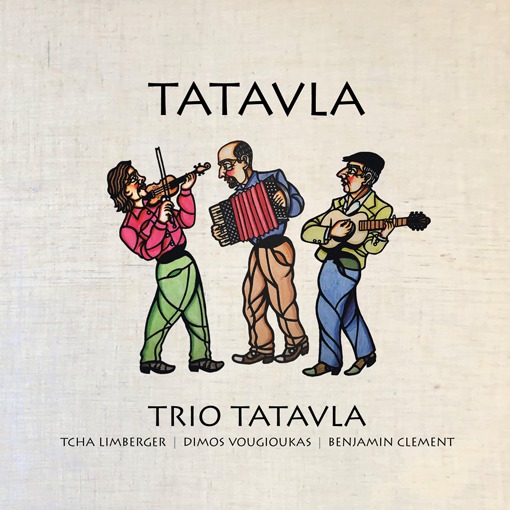Dimos Vougioukas – accordion
Tcha Limberger – violin
Benjamin Clement – guitar
With the precious help of the great Greek soloist of accordion Dimos Vougioukas, Tcha Limberger explores the wonders of Greek music present in Istanbul (Konstantinoupolis) and Smyrne (Asia Minor) at the beginning of the 20th century before Rebetiko. The intriguing rhythms Zeybek, Karsilama, Hasapiko and Kalamatiano with the full use of quarter tones similar to Turkish Makam, make Tcha’s attraction to this music almost indescribable.
Dimos Vougioukas has cooperated with well known soloists from Greece and Balkans such as Stavros Kouskouridas, Kyriakos Gouventas (Greece), Petar Ralchev (Bulgaria), Ionica Minune (Romania). He participates in the Greek orchestra “Estoudiantina” as a soloist, he redacts the orchestration-arrangements and he constitutes one of the founding members.
They are joined by Benjamin Clement on guitar, a Belgian musician who is very active in the background of great players such as Nedyalko Nedyalkov, Lakatos Roby, Kiriakos Gouventas and Marcel Ramba. He has the biggest and most precise knowledge of rhythm and harmony from almost any country in central and Eastern Europe.
HISTORY
Kurtuluş, (Turkish for Liberation, Salvation, formerly known as Tatavla meaning “horse stable in Greek: Ταταύλα) is a cosmopolitan neighborhood of Şişli whose population consists of Turks, Greeks (now almost completely emigrated), Armenians (who still live there in numbers), Kurds (who are relatively recent economic migrants), and Jews (who still live there in numbers). The Turkish name means “independence”, “deliverance” and also “good riddance”.
The quarter was originally built in the 16th century as a residential area for Chian Greeks, settled here to work in the principal dockyards of the Ottoman Empire which were situated in the neighboring Kasımpaşa quarter. In 1832, a fire swept and completely destroyed the neighborhood with 600 houses and 30 shops going up in flames. Tatavla emerged as an entirely Greek part of Istanbul, while during the 19th century reached a population of 20,000 and hosted several Orthodox churches, schools and tavernas. It was nicknamed Little Athens due to its Greek character.
The neighborhood’s name was changed to Kurtuluş, six years after the Republic of Turkey was founded, for its rebuilding and symbolizing its rejuvenation, after a fire swept and largely destroyed the neighborhood on April 13th 1929, with 207 houses going up in flames. Despite the turmoil of the Balkan War, followed by World War I and the following Greco-Turkish War (1919–1922) and the devastating fire, the neighborhood continued to retain its large Greek population and atmosphere, at least until the riots of 1955. It was typically the residential area for Greeks of more modest income, as opposed to, for example, Tarabya on the Bosphorus, where richer Greeks as well as rich Turks and Europeans lived. Nevertheless, a number of beautiful houses were built in the late 19th century, some of which still stand today.
Kurtuluş, was also the place that ended the Baklahorani carnival, an annual event led by the Greek community of the city, which was banned by the Turkish authorities in 1943, but got revived in 2010.
YOUTUBE PLAYLIST
TATAVLA – TRACKLIST 2017
-
Trio Tatavla
Foties
-
Trio Tatavla
Manes tis kalinihtias
-
Trio Tatavla
Megaritikos karsilamas
-
Trio Tatavla
Memetis
-
Trio Tatavla
Pergamos
-
Trio Tatavla
Ematha pos paizeis zaria
-
Trio Tatavla
Vale me stin agkalia sou
-
Trio Tatavla
Antikrystos horos
-
Trio Tatavla
Smyrni me ta perichora
-
Trio Tatavla
Aptalikos from Mytilini
-
Trio Tatavla
Harmandalis zeibekiko
-
Trio Tatavla
Romanian cantec, Manes tis augis
For complete CD listing please click here
























